Bifidobacterium breve-derived indole-3-lactic acid ameliorates colitis-associated tumorigenesis by directing the differentiation of immature colonic macrophages
- PMID: 38773969
- PMCID: PMC11103503
- DOI: 10.7150/thno.92350
Bifidobacterium breve-derived indole-3-lactic acid ameliorates colitis-associated tumorigenesis by directing the differentiation of immature colonic macrophages
Abstract
Aim: To elucidate dynamics and functions in colonic macrophage subsets, and their regulation by Bifidobacterium breve (B. breve) and its associated metabolites in the initiation of colitis-associated colorectal cancer (CAC). Methods: Azoxymethane (AOM) and dextran sodium sulfate (DSS) were used to create a CAC model. The tumor-suppressive effect of B. breve and variations of macrophage subsets were evaluated. Intestinal macrophages were ablated to determine their role in the protective effects of B. breve. Efficacious molecules produced by B. breve were identified by non-targeted and targeted liquid chromatography-tandem mass spectrometry (LC-MS/MS) analysis. The molecular mechanism was further verified in murine bone marrow-derived macrophages (BMDMs), macrophages derived from human peripheral blood mononuclear cells (hPBMCs), and demonstrated in CAC mice. Results: B. breve alleviated colitis symptoms, delayed colonic tumorigenesis, and promoted phenotypic differentiation of immature inflammatory macrophages into mature homeostatic macrophages. On the contrary, the ablation of intestinal macrophages largely annulled the protective effects of B. breve. Microbial analysis of colonic contents revealed the enrichment of probiotics and the depletion of potential pathogens following B. breve supplementation. Moreover, indole-3-lactic acid (ILA) was positively correlated with B. breve in CAC mice and highly enriched in the culture supernatant of B. breve. Also, the addition of ILA directly promoted AKT phosphorylation and restricted the pro-inflammatory response of murine BMDMs and macrophages derived from hPBMCs in vitro. The effects of ILA in murine BMDMs and macrophages derived from hPBMCs were abolished by the aryl hydrocarbon receptor (AhR) antagonist CH-223191 or the AKT inhibitor MK-2206. Furthermore, ILA could protect against tumorigenesis by regulating macrophage differentiation in CAC mice; the AhR antagonist largely abrogated the effects of B. breve and ILA in relieving colitis and tumorigenesis. Conclusion: B. breve-mediated tryptophan metabolism ameliorates the precancerous inflammatory intestinal milieu to inhibit tumorigenesis by directing the differentiation of immature colonic macrophages.
Keywords: Bifidobacterium breve; aryl hydrocarbon receptor; colitis-associated tumorigenesis; indole-3-lactic acid; macrophage differentiation.
© The author(s).
Conflict of interest statement
Competing Interests: The authors have declared that no competing interest exists.
Figures
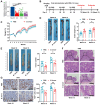
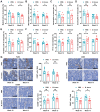
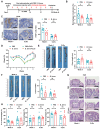
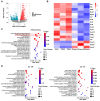
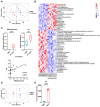
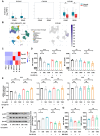
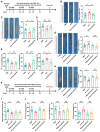
Similar articles
-
Altered gut metabolites and metabolic reprogramming involved in the pathogenesis of colitis-associated colorectal cancer and the transition of colon "inflammation to cancer".J Pharm Biomed Anal. 2025 Jan 15;253:116553. doi: 10.1016/j.jpba.2024.116553. Epub 2024 Oct 28. J Pharm Biomed Anal. 2025. PMID: 39486392
-
Berberine regulates short-chain fatty acid metabolism and alleviates the colitis-associated colorectal tumorigenesis through remodeling intestinal flora.Phytomedicine. 2022 Jul 20;102:154217. doi: 10.1016/j.phymed.2022.154217. Epub 2022 May 27. Phytomedicine. 2022. PMID: 35660350
-
Administration of Bifidobacterium bifidum CGMCC 15068 modulates gut microbiota and metabolome in azoxymethane (AOM)/dextran sulphate sodium (DSS)-induced colitis-associated colon cancer (CAC) in mice.Appl Microbiol Biotechnol. 2020 Jul;104(13):5915-5928. doi: 10.1007/s00253-020-10621-z. Epub 2020 May 4. Appl Microbiol Biotechnol. 2020. PMID: 32367312
-
Role of the global gut microbial community in the development of colitis-associated cancer in a murine model.Biomed Pharmacother. 2021 Mar;135:111206. doi: 10.1016/j.biopha.2020.111206. Epub 2021 Jan 5. Biomed Pharmacother. 2021. PMID: 33418307
-
Bifidobacterium breve attenuates murine dextran sodium sulfate-induced colitis and increases regulatory T cell responses.PLoS One. 2014 May 2;9(5):e95441. doi: 10.1371/journal.pone.0095441. eCollection 2014. PLoS One. 2014. PMID: 24787575 Free PMC article.
Cited by
-
Indole-3-lactic acid suppresses colorectal cancer via metabolic reprogramming.Gut Microbes. 2025 Dec;17(1):2508949. doi: 10.1080/19490976.2025.2508949. Epub 2025 May 23. Gut Microbes. 2025. PMID: 40409349 Free PMC article.
-
The gut microbiota in cancer immunity and immunotherapy.Cell Mol Immunol. 2025 Aug 6. doi: 10.1038/s41423-025-01326-2. Online ahead of print. Cell Mol Immunol. 2025. PMID: 40770084 Review.
-
Regulation and Function of Tumor-Associated Macrophages (TAMs) in Colorectal Cancer (CRC): The Role of the SRIF System in Macrophage Regulation.Int J Mol Sci. 2025 Jun 1;26(11):5336. doi: 10.3390/ijms26115336. Int J Mol Sci. 2025. PMID: 40508145 Free PMC article. Review.
-
Common mechanisms of Gut microbe-based strategies for the treatment of intestine-related diseases: based on multi-target interactions with the intestinal barrier.Cell Commun Signal. 2025 Jun 18;23(1):288. doi: 10.1186/s12964-025-02299-5. Cell Commun Signal. 2025. PMID: 40528179 Free PMC article. Review.
-
The interplay between gut bacteria and targeted therapies: implications for future cancer treatments.Mol Med. 2025 Feb 13;31(1):58. doi: 10.1186/s10020-025-01108-6. Mol Med. 2025. PMID: 39948481 Free PMC article. Review.
References
-
- Baars JE, Looman CW, Steyerberg EW, Beukers R, Tan AC, Weusten BL. et al. The risk of inflammatory bowel disease-related colorectal carcinoma is limited: results from a nationwide nested case-control study. Am J Gastroenterol. 2011;106:319–28. - PubMed
-
- Lu MJ, Qiu XY, Mao XQ, Li XT, Zhang HJ. Systematic review with meta-analysis: thiopurines decrease the risk of colorectal neoplasia in patients with inflammatory bowel disease. Aliment Pharmacol Ther. 2018;47:318–31. - PubMed
-
- Delfini M, Stakenborg N, Viola MF, Boeckxstaens G. Macrophages in the gut: Masters in multitasking. Immunity. 2022;55:1530–48. - PubMed
-
- Na YR, Stakenborg M, Seok SH, Matteoli G. Macrophages in intestinal inflammation and resolution: a potential therapeutic target in IBD. Nat Rev Gastroenterol Hepatol. 2019;16:531–43. - PubMed
Publication types
MeSH terms
Substances
LinkOut - more resources
Full Text Sources
Research Materials

